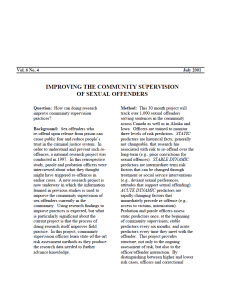Improving the community supervision of sexual offenders
Research summary
Vol. 6 No. 4
July 2001
Question
How can doing research improve community supervision practices?
Background
Sex offenders who re-offend upon release from prison can cause public fear and reduce people's trust in the criminal justice system. In order to understand and prevent such re-offences, a national research project was conducted in 1997. In this retrospective study, parole and probation officers were interviewed about what they thought might have triggered re-offences in earlier cases. A new research project is now underway in which the information learned in previous studies is used to improve the community supervision of sex offenders currently in the community. Using research findings to improve practices is expected, but what is particularly significant about the current project is that the process of doing research itself improves field practice. In this project, community supervision officers learn state-of-the-art risk assessment methods as they produce the research data needed to further advance knowledge.
Method
This 30 month project will track over 1,000 sexual offenders serving sentences in the community across Canada as well as in Alaska and Iowa. Officers are trained to monitor three levels of risk predictors. STATIC predictors are historical facts, generally not changeable, that research has associated with risk to re-offend over the long-term (e.g., prior convictions for sexual offences). STABLE DYNAMIC predictors are intermediate term risk factors that can be changed through treatment or social service interventions (e.g., deviant sexual preferences, attitudes that support sexual offending). ACUTE DYNAMIC predictors are rapidly changing factors that immediately precede re-offence (e.g., access to victims, intoxication). Probation and parole officers assess static predictors once, at the beginning of community supervision; stable predictors every six months; and acute predictors every time they meet with the offender. This project provides structure, not only to the ongoing assessment of risk, but also to the officer/offender interaction. By distinguishing between higher and lower risk cases, officers and correctional administrators can apportion their time and resources according to the level of risk to public safety posed by an offender. Research has shown that correctional resources are best utilised when the most resources are concentrated on higher risk offenders.
Likely Outcomes
Through the process of actually doing research, information is transmitted to the field and adopted by officers, thereby promoting the continual improvement of best practices. This research will produce a nationally recognised sex offender risk assessment instrument that is easy to use, widely applicable, and useful to community supervision officers. The resultant test will provide officers with estimates of "what are the chances that an offender will reoffend", "when should the officer intervene" and if they chose to intervene, "what should be the intervention targets of choice?"
Policy implications
- Although research is often considered a costly initial investment with potential for future benefit, the current project demonstrates how the implementation of research projects can provide immediate benefits to the field. Researchers and practitioners should seek opportunities for such "win-win" collaborations whenever possible.
- This project will provide a validated risk assessment instrument for sexual offenders that will allow correctional authorities to more efficiently channel resources according to risk.
- This project will provide parole/probation officers and correctional authorities with a national common vocabulary of risk for sexual offenders, facilitating inter-officer and inter-jurisdictional transfer of risk information.
Source
- Hanson, R.K., & Harris, A. J. R. (1998). Dynamic predictors of sexual recidivism. (User Report 1998-01). Ottawa: Department of the Solicitor General of Canada.
- Hanson, R. K., & Harris, A. J. R. (2000). The sex offender need assessment rating (SONAR): A method for measuring change in risk levels. (User Report 2000-01). Ottawa: Department of the Solicitor General of Canada.
For further information
James Bonta, Ph.D.
Public Safety Canada
340 Laurier Avenue West
Ottawa, Ontario
K1A 0P8
Tel 613-991-2831
Fax 613-990-8295
E-mail Jim.bonta@ps-sp.gc.ca
- Date modified:
